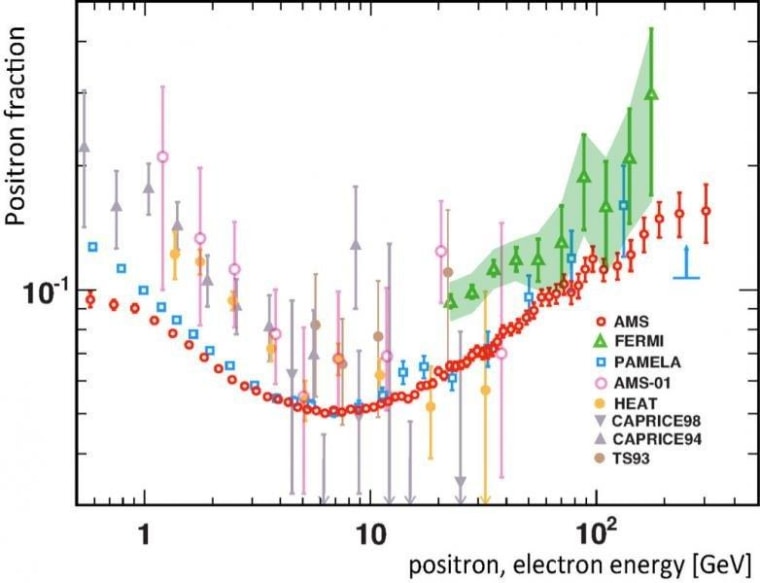Scientists say a $2 billion antimatter-hunting experiment on the International Space Station has detected its first hints of dark matter, the mysterious stuff that makes up almost a quarter of the universe.
The evidence from the Alpha Magnetic Spectrometer, revealed Wednesday at Europe's CERN particle physics lab, is based on an excess in the cosmic production of anti-electrons, also known as positrons. The AMS research team can't yet rule out other explanations for the excess, but the fresh findings provide the best clues yet as to the nature of dark matter.
"Over the coming months, AMS will be able to tell us conclusively whether these positrons are a signal for dark matter, or whether they have some other origin," Samuel Ting, an astrophysicist at the Massachusetts Institute of Technology who leads the international AMS collaboration, said in a CERN news release.
The results have been published in Physical Review Letters and were discussed during a NASA news conference.
Dark matter is so named because it hasn't been detected directly through electromagnetic emissions, but primarily through its gravitational effect. Precise measurements of the movements of galaxies and galaxy clusters, as well as studies of the big bang's afterglow, indicate that it accounts for 22.7 percent of the universe's content. Another mysterious factor known as dark energy makes up 72.8 percent, leaving just 4.5 percent for ordinary matter.
Scientists have theorized that ultra-high-energy collisions involving dark matter particles could produce more positrons than expected. The best places to detect such collisions are in huge underground experiments such as CERN's Large Hadron Collider — or in outer space, where cosmic rays can be measured more easily than they are on Earth.
The Alpha Magnetic Spectrometer is the most sensitive cosmic-ray detector ever put into orbit. Researchers from 16 countries worked for well more than a decade to get AMS ready for the space station, but it literally took an act of Congress to get the extra money needed for the launch. The bus-sized device was brought up on the shuttle Endeavour and installed in 2011, during the shuttle fleet's second-last mission.
Since then, readings from the AMS have been flowing in to Ting and his colleagues for analysis. CERN said the results announced on Wednesday are based on 25 billion recorded events, including 400,000 positrons with energies between 500 million electron volts and 350 billion electron volts. "This represents the largest collection of antimatter particles recorded in space," CERN said.
Researchers noticed an increase in the fraction of positrons detected in the range of 10 billion to 250 billion electron volts. They said the data showed no significant variation over time, or any preferred incoming direction. All this is consistent with the annihilation of dark matter particles in space.

Other experiments have recorded similar increases in positron production, but AMS was able to chart the rise in unprecedented detail. Ting compared the resolution to seeing something with the naked eye vs. an electron microscope. "It is these fine features that are the difference between us and the rest of the experiments," he told reporters.
Further evidence is needed, however: It's possible that the bump in positrons could be created by emissions from pulsars spread across the galactic plane. The most promising hypothesis suggests that dark matter is part of a yet-to-be-detected array of "supersymmetric" particles, and if that concept is correct, researchers should see a sharp drop in the positron emissions at energies higher than 250 billion electron volts.
Ting said there's not yet enough data to render a decision about such a drop-off. "We want to know how quickly it drops off, how sharp is the drop-off," he told NBC News. "It's the way it drops off that tells you whether it's dark matter collisions, or from pulsars."
He pointed out that the newly released findings are based on just 10 percent of the data AMS is expected to collect.
"When you take a new precision instrument into a new regime, you tend to see many new results, and we hope this this will be the first of many," Ting said. "AMS is the first experiment to measure to 1 percent accuracy in space. It is this level of precision that will allow us to tell whether our current positron observation has a dark matter or pulsar origin."
Future revelations are expected to come from AMS as well as from the Large Hadron Collider and other underground laboratories.
"The AMS result is a great example of the complementarity of experiments on Earth and in space,” CERN Director General Rolf Heuer said in Wednesday's statement. “Working in tandem, I think we can be confident of a resolution to the dark matter enigma sometime in the next few years."
Update for 4:40 p.m. ET April 3: One of the experiments that could make a direct detection of dark matter particles in the months ahead is the Large Underground Xenon Experiment. LUX is located in an old gold mine, almost a mile deep in the Black Hills of South Dakota. The project's scientists will keep watch for telltale interactions between dark matter and the xenon in their detector. In an emailed statement, LUX co-spokesperson Richard Gaitskell, a physicist at Brown University, hailed the AMS results but said that questions remain:
"Obviously it’s a fantastic new instrument. It’s considerably more sensitive than anything we’ve previously flown as far as looking for antiparticles. So it’s a tremendous step forward.
"The results themselves are consistent with a flux of antiparticles that come from dark matter. On the downside, no aspect of the data that’s been discussed so far allows one to differentiate between an explanation that these antiparticles are coming from dark matter or from another astrophysical source.
"What we see is that at the higher-energy regime that the detector, there is a significant increase in the positron flux. That’s interesting, but it’s been recorded by previous instruments. What we were hoping to see was some additional structure. We’d like to see a bump that has some upper energy threshold or edge, rather just a rise at higher energies. Right now, the new data from AMS does not provide a definitive indication of an upper edge. We’d like to see something like that as direct evidence of dark matter."
NASA Administrator Charles Bolden issued a statement that focusing on the roles played by the space agency and the International Space Station. " I am confident that this is only the first of many scientific discoveries enabled by the station that will change our understanding of the universe," Bolden said. "Multiple NASA human spaceflight centers around the country played important roles in this work, and we look forward to many more exciting results from AMS."
More about dark matter:
To watch the full NASA news conference, click to the 48-minute mark in this Ustream recording.
Alan Boyle is NBCNews.com's science editor. Connect with the Cosmic Log community by "liking" the log's Facebook page, following @b0yle on Twitter and adding the Cosmic Log page to your Google+ presence. To keep up with Cosmic Log as well as NBCNews.com's other stories about science and space, sign up for the Tech & Science newsletter, delivered to your email in-box every weekday. You can also check out "The Case for Pluto," my book about the controversial dwarf planet and the search for new worlds.
